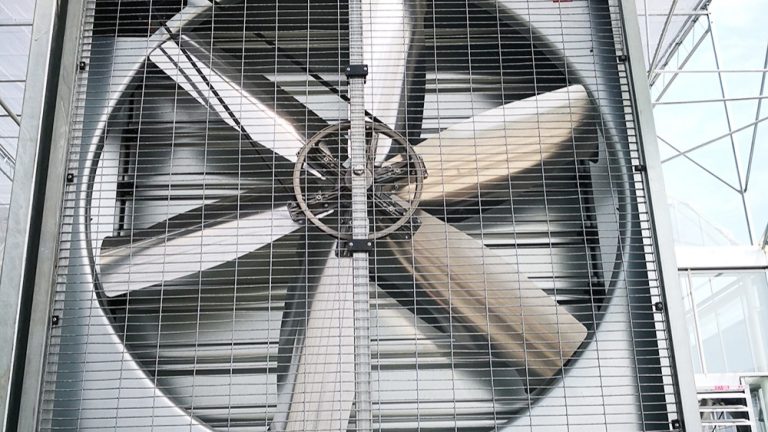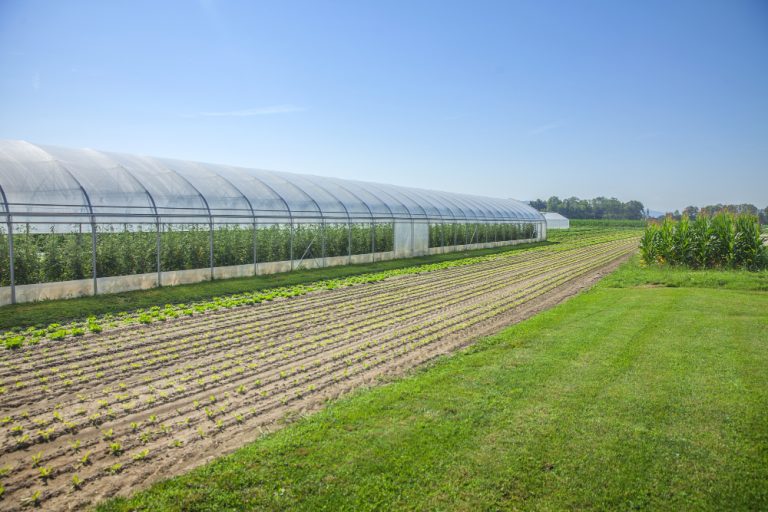
How Greenhouses Maintain Temperature
Greenhouses create a warm environment for plants by letting sunlight in through glass walls, which then turns into heat inside. This heat is partially trapped by the glass, keeping the inside warmer than outside, a process known as the greenhouse effect. Even though some heat escapes through the glass, the continuous heat from the sun during the day, along with additional heating systems when needed, helps maintain a suitable temperature for plants.
The Greenhouse Effect
The glass allows visible light to pass through, which plants and soil absorb and convert into heat. This heat, in the form of infrared radiation, is mostly blocked by the glass, preventing it from escaping easily and keeping the greenhouse warm.
Managing Heat Loss
While glass isn’t a perfect insulator, greenhouses use energy-efficient glass or double layers to reduce heat loss. They also ensure tight seals to minimize air leaks and may use thermal curtains at night to further insulate.
Additional Heating and Cooling
In colder weather or at night, greenhouses often have heating systems like boilers or heaters to maintain temperature. During hot days, ventilation and shading help release excess heat, preventing the greenhouse from getting too warm.
An unexpected detail is that the type of glass, such as insulated or low-emissivity glass, can significantly reduce heat loss, making heating more efficient and cost-effective, especially in colder climates.
Survey Note: Detailed Analysis of Greenhouse Temperature Maintenance
Greenhouses are specialized structures designed to create controlled environments for plant growth, particularly in conditions where external temperatures are unsuitable. The question of how they maintain a suitable temperature for plants despite releasing heat energy through their glass walls involves understanding the interplay of heat gain, heat loss, and temperature regulation mechanisms. This note provides a comprehensive exploration based on recent research and practical insights, expanding on the direct answer with detailed technical and operational considerations.
The Greenhouse Effect: Trapping Solar Heat
The fundamental principle behind greenhouse temperature maintenance is the greenhouse effect, where glass or plastic coverings allow visible light to penetrate while trapping heat. Sunlight, composed of visible and infrared wavelengths, enters the greenhouse, and the visible light is absorbed by plants, soil, and other interior surfaces. This absorption converts light energy into heat, which is then emitted as infrared radiation. Glass, particularly, is less transparent to infrared radiation, with research indicating that it transmits only about 4% of infrared energy compared to 70% for polyethylene (Understanding (And Avoiding) Heat Loss – Greenhouse Product News). This property helps retain heat inside, creating a warmer interior than the external environment, even during cold periods.
For example, during daylight hours, the temperature inside a greenhouse can rise significantly, often reaching 80 to 85°F (27 to 29°C), as noted in studies on greenhouse temperature control (Mastering Greenhouse Gardening: Tips for Year-Round Success | LoveToKnow). This natural solar heating is crucial, especially in winter, allowing plants to thrive despite low external temperatures.
Heat Loss Through Glass Walls: Conduction and Beyond
Despite the heat-trapping effect, greenhouses do release heat energy through their glass walls, primarily via conduction, where heat flows from the warmer interior to the cooler exterior. Glass has a relatively high thermal conductivity compared to other materials, with a U-value (heat transfer coefficient) typically around 5.8 W/m²K for single-layer glass, indicating significant heat loss potential (Greenhouse Glazing: Glass). Other forms of heat loss include convection, where warm air near the glass escapes, and radiation, where infrared energy is emitted directly through the covering.
Research highlights that glass greenhouses, compared to those using double-poly or polycarbonate, have higher operating costs due to this heat loss, as they require more energy for heating (Greenhouse Glazing: Glass). For instance, a standard greenhouse wall with double-wall polycarbonate has an R-value (resistance to heat flow) of about 1.5, while a typical home wall with insulation might have an R-value of 30, showing glass’s poorer insulating properties (Greenhouse & Floriculture: Insulating Sidewalls and Endwalls has a Short Payback | Center for Agriculture, Food, and the Environment at UMass Amherst).
Strategies to Manage Heat Loss
To maintain a suitable temperature despite this heat loss, greenhouses employ several strategies:
- Material Selection: Using energy-efficient glass, such as insulated double-glazed units, can lower the U-value. For instance, double-glazed glass can have a U-value as low as 2.8 W/m²K, significantly reducing heat loss compared to single-layer glass (Greenhouse Glass types | MORN GLASS-Best architectural glass supplier). Multi-skin polycarbonate sheets, with U-values as low as 1.5 W/m²K for 32mm thick sheets, offer even better insulation (Greenhouses made from PLEXIGLAS®).
- Insulation Techniques: Additional insulation methods, such as thermal curtains or blinds, are used, especially at night, to reduce heat loss. Insulating sidewalls and endwalls, particularly areas not critical for light transmission, can have a payback period of less than two years, according to energy audits (Greenhouse & Floriculture: Insulating Sidewalls and Endwalls has a Short Payback | Center for Agriculture, Food, and the Environment at UMass Amherst).
- Supplementary Heating: In colder climates or during nighttime, when solar gain is absent, greenhouses rely on supplementary heating systems. Options include forced air heating, gas or electric heaters, and even wood or pellet stoves, with forced air systems helping mix air to prevent temperature stratification (Greenhouses: Heating, Cooling and Ventilation | UGA Cooperative Extension). These systems ensure the temperature remains within the ideal range, typically 70°F at night and 80.6°F during the day for many plants (How to Maintain an Ideal Greenhouse Temperature – AcuRite).
- Ventilation and Shading: To prevent overheating during hot days, greenhouses use ventilation systems, such as roof vents and side louvers, to release excess heat. Shading, either through external shade cloths or internal blinds, reduces solar gain, maintaining temperatures suitable for plant growth (10 Tips on Greenhouse Temperature Control for Gardeners | Farm Plastic Supply). This is particularly important in regions with high solar radiation, where temperatures can exceed 100°F without regulation.
Balancing Heat Gain and Loss
The maintenance of temperature is ultimately a balance between heat gain and heat loss. During the day, solar radiation provides a continuous heat input, often sufficient to offset conductive losses through the glass. For example, studies show that solar heating can raise internal temperatures significantly, with the greenhouse effect ensuring that much of this heat is retained (Heating with the Greenhouse Effect | Scientific American). At night, without solar input, the heat loss through glass walls would cause temperatures to drop, necessitating supplementary heating to maintain plant health.
An interesting detail is the use of thermal mass, such as concrete floors or water barrels, which absorb heat during the day and release it slowly at night, stabilizing temperature fluctuations (How Greenhouses Stay Warm in the Winter). This passive strategy complements active heating systems, enhancing energy efficiency.
Practical Considerations and Variations
The effectiveness of these strategies varies with climate, greenhouse design, and plant type. For instance, in colder regions like northern Europe, glass greenhouses are common, but they require robust heating systems due to high heat loss (Greenhouse Glazing: Glass). In contrast, in warmer climates, the focus might be on cooling, with ventilation and shading being more critical. The choice of glazing material also affects light transmission, with glass offering 88% to 94% light transmittance for single layers, essential for photosynthesis (Glazing Materials).
Table: Comparison of Glazing Materials for Heat Loss and Insulation
| Material | U-Value (W/m²K) | Light Transmittance (%) | Notes |
|---|---|---|---|
| Single-layer Glass | ~5.8 | 88-94 | High heat loss, traditional choice |
| Double-glazed Glass | ~2.8 | ~77 | Better insulation, reduces heat loss |
| Twinwall Polycarbonate | ~2.5 | Up to 91 | Good insulation, lighter than glass |
| 32mm PLEXIGLAS® Resist | 1.5 | Up to 91 | Excellent insulation, used in modern designs |
This table, derived from various sources, illustrates how different glazing options impact heat loss and light transmission, aiding in selecting materials for temperature control.
Conclusion
Greenhouses maintain suitable temperatures for plants by leveraging the greenhouse effect to trap solar heat, minimizing heat loss through advanced glazing and insulation, and using supplementary heating and cooling systems as needed. Despite releasing heat through glass walls, the continuous solar gain during the day, combined with strategic design and management, ensures a stable environment. This balance is crucial for year-round plant growth, with variations depending on climate and operational needs.




